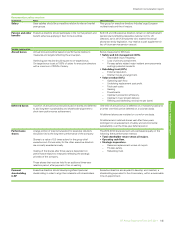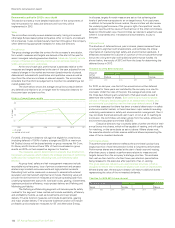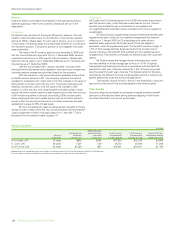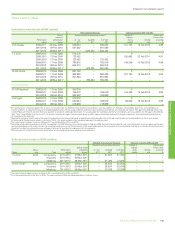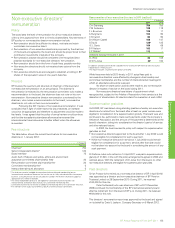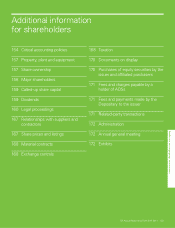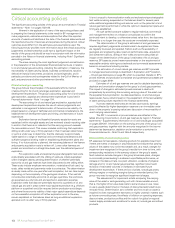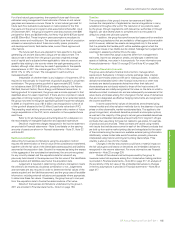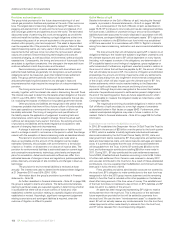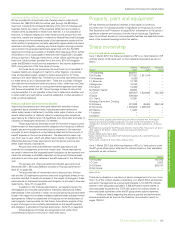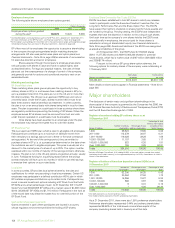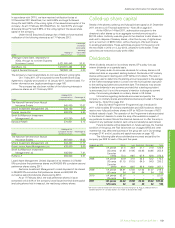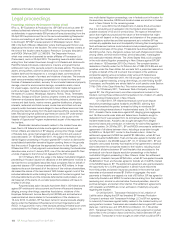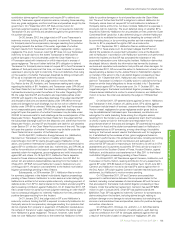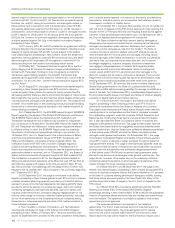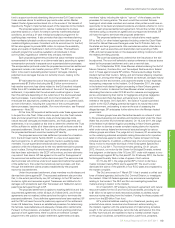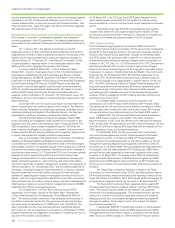BP 2011 Annual Report Download - page 156
Download and view the complete annual report
Please find page 156 of the 2011 BP annual report below. You can navigate through the pages in the report by either clicking on the pages listed below, or by using the keyword search tool below to find specific information within the annual report.
154 BP Annual Report and Form 20-F 2011
Additional information for shareholders
Critical accounting policies
The significant accounting policies of the group are summarized in Financial
statements – Note 1 on pages 182-189.
Inherent in the application of many of the accounting policies used
in preparing the financial statements is the need for BP management to
make judgements, estimates and assumptions that affect the reported
amounts of assets and liabilities at the date of the financial statements and
the reported amounts of revenues and expenses during the period. Actual
outcomes could differ from the estimates and assumptions used. The
following summary provides more information about the critical accounting
judgements and estimates that could have a significant impact on the
results of the group and should be read in conjunction with the information
provided in the Notes on financial statements, including Note 1 Significant
accounting policies.
The areas requiring the most significant judgement and estimation
in the preparation of the consolidated financial statements are in relation
to oil and natural gas accounting, including the estimation of reserves, the
recoverability of asset carrying values, business combinations, taxation,
derivative financial instruments, provisions and contingencies, and in
particular, provisions and contingencies related to the Gulf of Mexico oil
spill, and pensions and other post-retirement benefits.
Oil and natural gas accounting
The group follows the principles of the successful efforts method
of accounting for its oil and natural gas exploration, appraisal and
development expenditure. The group’s accounting policy for oil and natural
gas exploration, appraisal and development expenditure is provided in
Financial statements – Note 1 on page 184.
The accounting for oil and natural gas exploration, appraisal and
development expenditure requires the use of various judgements and
estimates in management’s determination of the economic viability of a
project based on a range of technical and commercial considerations, the
establishment of development plans and timing, and estimates of future
expenditure.
Exploration licence and leasehold property acquisition costs are
capitalized within intangible assets and are reviewed at each reporting date
to confirm that there is no indication that the carrying amount exceeds
the recoverable amount. This review includes confirming that exploration
drilling is still under way or firmly planned or that it has been determined,
or work is under way to determine, that the discovery is economically
viable based on a range of technical and commercial considerations and
sufficient progress is being made on establishing development plans and
timing. If no future activity is planned, the remaining balance of the licence
and property acquisition costs is written off. Lower value licences are
pooled and amortized on a straight-line basis over the estimated period of
exploration.
For exploration wells and exploratory-type stratigraphic test wells,
costs directly associated with the drilling of wells are initially capitalized
within intangible assets, pending determination of whether potentially
economic oil and gas reserves have been discovered by the drilling effort.
These costs include employee remuneration, materials and fuel used, rig
costs, delay rentals and payments made to contractors. The determination
is usually made within one year after well completion, but can take longer,
depending on the complexity of the geological structure. If the well did
not encounter potentially economic oil and gas quantities, the well costs
are expensed as a dry hole and are reported in exploration expense.
Exploration wells that discover potentially economic quantities of oil and
natural gas and are in areas where major capital expenditure (e.g. offshore
platform or a pipeline) would be required before production could begin,
and where the economic viability of that major capital expenditure depends
on the successful completion of further exploration work in the area,
remain capitalized on the balance sheet as long as additional exploration
appraisal work is under way or firmly planned.
It is not unusual to have exploration wells and exploratory-type stratigraphic
test wells remaining suspended on the balance sheet for several years
while additional appraisal drilling and seismic work on the potential oil and
natural gas field is performed or while the optimum development plans and
timing are established.
All such carried costs are subject to regular technical, commercial
and management review on at least an annual basis to confirm the
continued intent to develop, or otherwise extract value from, the discovery.
Where this is no longer the case, the costs are immediately expensed.
The determination of the group’s estimated oil and gas reserves
requires significant judgements and estimates to be applied and these
are regularly reviewed and updated. Factors such as the availability of
geological and engineering data, reservoir performance data, acquisition
and divestment activity, drilling of new wells and commodity prices all
impact on the determination of the group’s estimates of its oil and gas
reserves. BP bases its proved reserves estimates on the requirement of
reasonable certainty with rigorous technical and commercial assessments
based on conventional industry practice.
The estimation of oil and natural gas reserves and BP’s process
to manage reserves bookings is described in Exploration and Production
– Oil and gas disclosures on page 89, which is unaudited. Details on BP’s
proved reserves and production compliance and governance processes are
provided on pages 90-91.
Estimates of oil and gas reserves are used to calculate depreciation,
depletion and amortization charges for the group’s oil and gas properties.
The impact of changes in estimated proved reserves is dealt with
prospectively by amortizing the remaining carrying value of the asset over
the expected future production. As discussed below, oil and natural gas
reserves also have a direct impact on the assessment of the recoverability
of asset carrying values reported in the financial statements.
If proved reserves estimates are revised downwards, earnings
could be affected by higher depreciation expense or an immediate write-
down of the property’s carrying value (see discussion of recoverability of
asset carrying values below).
The 2011 movements in proved reserves are reflected in the
tables showing movements in oil and gas reserves by region in Financial
statements – Supplementary information on oil and natural gas (unaudited)
on pages 259-281. Information on the carrying amounts of the group’s oil
and gas properties, together with the amounts recognized in the income
statement as depreciation, depletion and amortization is contained in
Financial statements – Note 15 and Note 9 respectively.
Recoverability of asset carrying values
BP assesses its fixed assets, including goodwill, for possible impairment
if there are events or changes in circumstances that indicate that carrying
values of the assets may not be recoverable and, as a result, charges for
impairment are recognized in the group’s results from time to time, with
corresponding reductions in the carrying values of the group’s assets.
Such indicators include changes in the group’s business plans, changes
in commodity prices leading to sustained unprofitable performance, an
increase in the discount rate, low plant utilization, evidence of physical
damage and, for oil and natural gas properties, significant downward
revisions of estimated volumes or increases in estimated future
development expenditure. If there are low oil prices, natural gas prices,
refining margins or marketing margins during an extended period, the
group may need to recognize significant impairment charges.
The assessment for impairment entails comparing the carrying
value of the asset or cash-generating unit with its recoverable amount,
that is, the higher of fair value less costs to sell and value in use. Value
in use is usually determined on the basis of discounted estimated future
net cash flows. Determination as to whether and how much an asset is
impaired involves management estimates on highly uncertain matters such
as future commodity prices, the effects of inflation on operating expenses,
discount rates, production profiles and the outlook for global or regional
market supply-and-demand conditions for crude oil, natural gas and refined
products.



